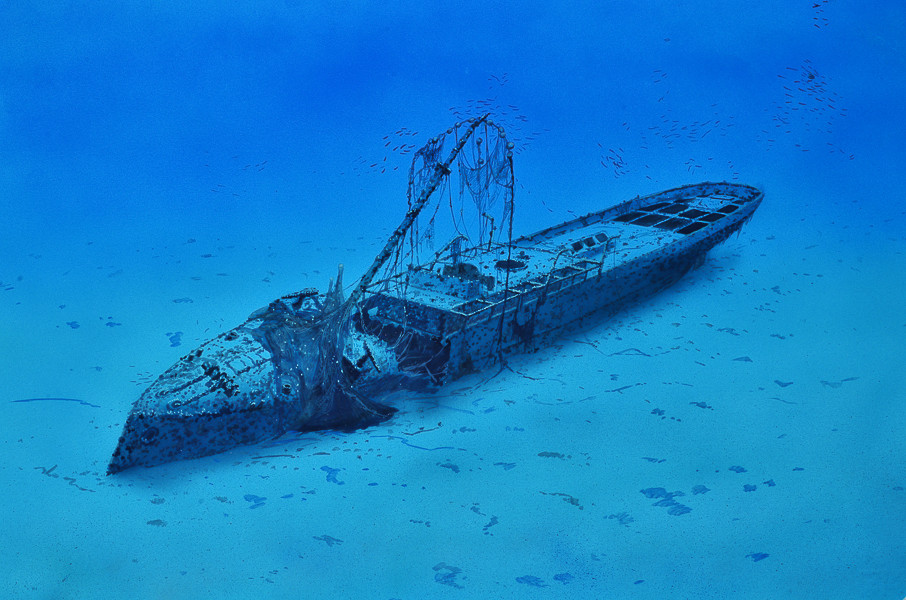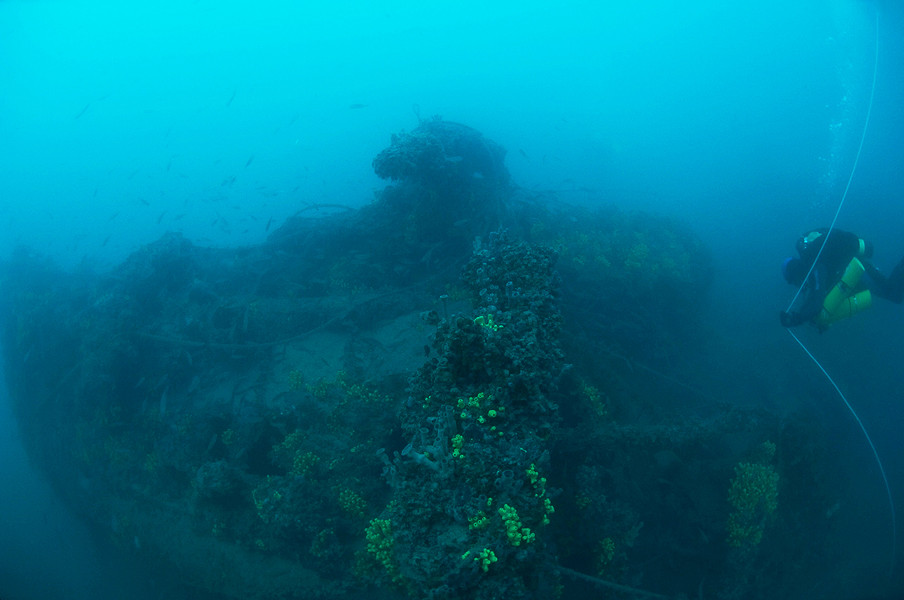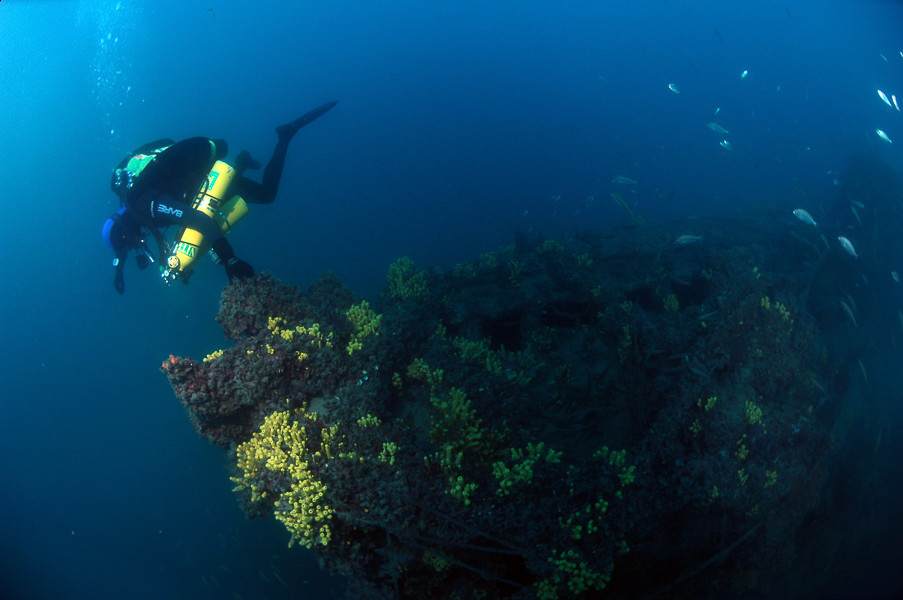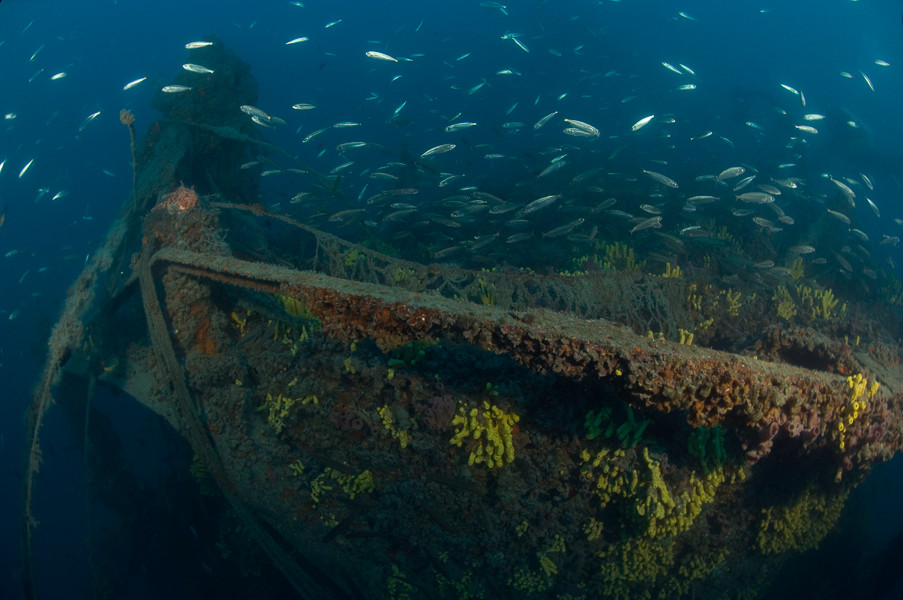
PELAGOSA
DEPTH: 50 - 55 m
SKILL: Expert
Pelagosa; patrol ship; Austro-Hungarian, Seebehörde
Built: Trieste, 1898
Sunk: 12th February 1918 (torpedo, Italian F7 submarine)
Dimensions: l=48.73 m, w=6.28 m, h=3.1 m
Coordinates: 44.41292° N, 14.47923° E
Location: 3 nm W from the island of Grujica
Access: 1/5 access only by boat
Visibility: 3-4/5 good, occasionally very good
Current: 4/5 mostly weak
Flora and fauna: 4/5 varied life on and around the wreck
HISTORY:
The coastal cruise steamship Pelagosa was built by order of the Austro-Hungarian Navy authority (Seebehörde) from Trieste at the end of 19th century. It was launched back in 1898 from the Trieste shipyard.
With the outbreak of the First World War, the Austro-Hungarian Navy began to hire individual merchant ships for freight and troop transportation, as well as for various naval auxiliary missions. The Pelagosa was hired on 7th May 1915. It initially supervised the barricades in the Fažana Channel, but was later transferred to patrol service. In February 1918 it was added to the anti-submarine flotilla.
On 12th February 1918, the Pelagosa the Zadar and Pelagosa were patrolling the area to the south of Susak to disperse enemy submarines before the arrival of the convoy. At exactly 1630 hrs. at a direction of 20º and at a distance of 300 m, a submarine’s periscope was noticed. The engine room was ordered to “full speed” and as the Pelagosa was turning into a course towards the submarine, the second submarine fired its torpedoes. The first passed below the bow, but the second struck on the side of the ship, approximately 10 metres from the bow. A terrible explosion shook the ship and lifted a high column of water into the air, and with it all the sailors from the bow and bridge fell into the sea. The Pelagosa immediately sank at the bow about 1 metre. The bow was half split open and bent to the left from the explosion. The forward crew area quickly filled with water, and a number of larger and smaller holes which could not be plugged. At 1650 hrs. the crew abandoned the ship.
During this time the Zadar avoided another attack from the enemy submarine which was trying to find a favourable position for launching its torpedoes. The Zadar showered the periscope with mortar grenades and was navigating to where the dived submarine was. As the Pelagosa did not continue to sink, the crew returned to the boat and tried to start the engine. They succeeded, and the commander tried to reach the coast of Lošinj navigating with the stern. However, despite the engine working at full capacity, the ship was turning in circles due to the severely bent bow which was behaving like a large rudder.
The fleet of torpedo boats appeared on the scene and began the hunt for the submarine, the torpedo boat TB 89 took the Pelagosa in tow. However, when the sea reached the engine room of the Pelagosa, the commander gave the order to abandon ship for the second time. At 1822 hrs., the Pelagosa leaned to its port and sank. The fortune in this misfortune was that there were no human casualties.
WRECK CONDITION AND DIVING:
The wreck of the Pelagosa was found at the beginning of the 2000’s by Živko Žagar a diver from Mali Lošinj. Fishing nets were often snagged on it and Živko, while trying to free his net, came across the unknown wreck, which with the help of literature and a historian he managed to identify it as the Pelagosa.
The ship lies on a flat silty seabed at the depth of 51-52 m in an upright position. The hull is partially sunken in the silt almost to the water line, whilst the bow section is bent to the left and almost placed on its left side. The panelling where the boat was hit by the torpedo is completely torn, in an unrecognisable heap of plating and ribs only individual parts of equipment are partially recognisable. The anchoring gear and the two anchors are clearly visible on the bow. All the other sections of the ship construction – remains of the superstructure, davits for the lifeboats, railings, are all covered with thick layers of crustaceans, algae and sponges. The superstructure is preserved in the central section, where the square steel construction still stands above the main deck. The foremast has fallen over the front section of the superstructure. Nothing remains of the wooden wheelhouse, except pieces of the steel frame. Above them stands a large loop consisting of a thick nylon rope with the remains of a fishing net, so one should go carefully through this part as not to become caught on the debris. A couple of large conger eels guard the entrance to the lower decks. On the stern section which is still well-preserved, the place where the aft superstructure once stood is visible. Through the transverse steel frames on the main deck the whole interior of the ship can be seen which is all covered with a fine silt. The elegantly rounded stern is always covered with shoals of tiny fish, and on the rear railing large groupers can normally be seen.
The depth of over 50 metres requires the use of equipment for technical diving and it doesn’t allow for a long exploration with open circuit regulators, but with a rebreather regulator diving to this wreck can be a real pleasure.
The description and illustrations are a courtesy of Danijel Frka and Jasen Mesić. Buy the whole book here: https://shop.naklada-val.hr/product_info.php?products_id=561
Built: Trieste, 1898
Sunk: 12th February 1918 (torpedo, Italian F7 submarine)
Dimensions: l=48.73 m, w=6.28 m, h=3.1 m
Coordinates: 44.41292° N, 14.47923° E
Location: 3 nm W from the island of Grujica
Access: 1/5 access only by boat
Visibility: 3-4/5 good, occasionally very good
Current: 4/5 mostly weak
Flora and fauna: 4/5 varied life on and around the wreck
HISTORY:
The coastal cruise steamship Pelagosa was built by order of the Austro-Hungarian Navy authority (Seebehörde) from Trieste at the end of 19th century. It was launched back in 1898 from the Trieste shipyard.
With the outbreak of the First World War, the Austro-Hungarian Navy began to hire individual merchant ships for freight and troop transportation, as well as for various naval auxiliary missions. The Pelagosa was hired on 7th May 1915. It initially supervised the barricades in the Fažana Channel, but was later transferred to patrol service. In February 1918 it was added to the anti-submarine flotilla.
On 12th February 1918, the Pelagosa the Zadar and Pelagosa were patrolling the area to the south of Susak to disperse enemy submarines before the arrival of the convoy. At exactly 1630 hrs. at a direction of 20º and at a distance of 300 m, a submarine’s periscope was noticed. The engine room was ordered to “full speed” and as the Pelagosa was turning into a course towards the submarine, the second submarine fired its torpedoes. The first passed below the bow, but the second struck on the side of the ship, approximately 10 metres from the bow. A terrible explosion shook the ship and lifted a high column of water into the air, and with it all the sailors from the bow and bridge fell into the sea. The Pelagosa immediately sank at the bow about 1 metre. The bow was half split open and bent to the left from the explosion. The forward crew area quickly filled with water, and a number of larger and smaller holes which could not be plugged. At 1650 hrs. the crew abandoned the ship.
During this time the Zadar avoided another attack from the enemy submarine which was trying to find a favourable position for launching its torpedoes. The Zadar showered the periscope with mortar grenades and was navigating to where the dived submarine was. As the Pelagosa did not continue to sink, the crew returned to the boat and tried to start the engine. They succeeded, and the commander tried to reach the coast of Lošinj navigating with the stern. However, despite the engine working at full capacity, the ship was turning in circles due to the severely bent bow which was behaving like a large rudder.
The fleet of torpedo boats appeared on the scene and began the hunt for the submarine, the torpedo boat TB 89 took the Pelagosa in tow. However, when the sea reached the engine room of the Pelagosa, the commander gave the order to abandon ship for the second time. At 1822 hrs., the Pelagosa leaned to its port and sank. The fortune in this misfortune was that there were no human casualties.
WRECK CONDITION AND DIVING:
The wreck of the Pelagosa was found at the beginning of the 2000’s by Živko Žagar a diver from Mali Lošinj. Fishing nets were often snagged on it and Živko, while trying to free his net, came across the unknown wreck, which with the help of literature and a historian he managed to identify it as the Pelagosa.
The ship lies on a flat silty seabed at the depth of 51-52 m in an upright position. The hull is partially sunken in the silt almost to the water line, whilst the bow section is bent to the left and almost placed on its left side. The panelling where the boat was hit by the torpedo is completely torn, in an unrecognisable heap of plating and ribs only individual parts of equipment are partially recognisable. The anchoring gear and the two anchors are clearly visible on the bow. All the other sections of the ship construction – remains of the superstructure, davits for the lifeboats, railings, are all covered with thick layers of crustaceans, algae and sponges. The superstructure is preserved in the central section, where the square steel construction still stands above the main deck. The foremast has fallen over the front section of the superstructure. Nothing remains of the wooden wheelhouse, except pieces of the steel frame. Above them stands a large loop consisting of a thick nylon rope with the remains of a fishing net, so one should go carefully through this part as not to become caught on the debris. A couple of large conger eels guard the entrance to the lower decks. On the stern section which is still well-preserved, the place where the aft superstructure once stood is visible. Through the transverse steel frames on the main deck the whole interior of the ship can be seen which is all covered with a fine silt. The elegantly rounded stern is always covered with shoals of tiny fish, and on the rear railing large groupers can normally be seen.
The depth of over 50 metres requires the use of equipment for technical diving and it doesn’t allow for a long exploration with open circuit regulators, but with a rebreather regulator diving to this wreck can be a real pleasure.
The description and illustrations are a courtesy of Danijel Frka and Jasen Mesić. Buy the whole book here: https://shop.naklada-val.hr/product_info.php?products_id=561








 The investment is co-financed by the Republic of Slovenia and the European Union from the European Regional Development Fund.
The investment is co-financed by the Republic of Slovenia and the European Union from the European Regional Development Fund.  H2O Globe BETA
H2O Globe BETA